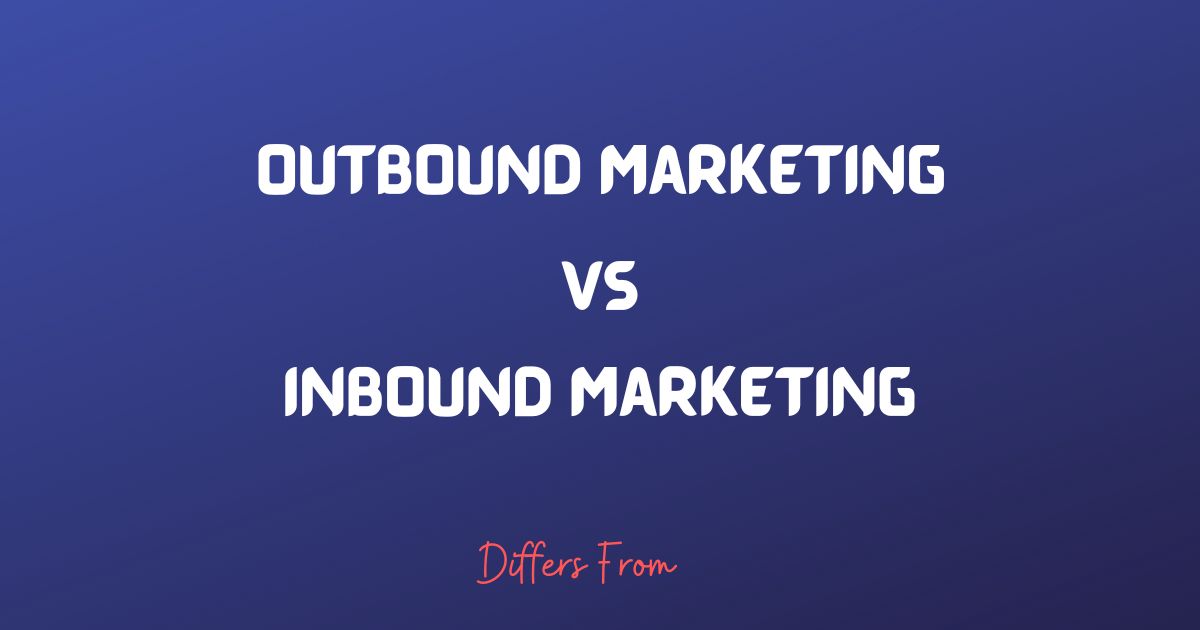Outbound and inbound marketing are two distinct approaches businesses use to engage with their target audience and promote their products or services.
Outbound marketing, often traditional or interruptive, involves pushing messages out to a broad audience through advertising, cold calling, and direct mail.
On the other hand, inbound marketing focuses on attracting and engaging the audience through valuable content, search engine optimization, and social media marketing.
Understanding the difference between outbound and inbound marketing is essential for businesses to develop effective marketing campaigns in today’s dynamic and competitive landscape.
What Is Outbound Marketing?
Outbound marketing is a traditional approach in which businesses push promotional messages to a large audience through advertising, telemarketing, direct mail, and other interruption-based methods.
It involves reaching out to potential customers who may or may not be interested in the product or service offered.
This strategy aims to raise brand awareness and capture attention through interruptive tactics that rely on a wide reach rather than specific targeting.
Types of Outbound Marketing
Like a loud megaphone in a crowded space, outbound marketing demands attention by interrupting people’s daily lives. It’s a classic technique that seeks to capture widespread awareness but often needs help to deliver the personalized and targeted experience that modern consumers crave.
Strategies and tactics
Outbound marketing strategies and tactics encompass various methods such as traditional advertising (TV, radio, print), cold calling, direct mail campaigns, and participating in trade shows and events.
These techniques are employed to proactively reach a wide audience and promote products or services through interruptive and proactive communication.
Interruption-based advertising
It involves pushing promotional messages to a wide audience through traditional channels like television, radio, print media, and online display ads.
Characteristics
Messages are delivered without the recipient actively seeking or requesting them, interrupting their attention.
Cold calling and telemarketing
Definition: It involves making unsolicited phone calls to potential customers to promote products or services.
Characteristics
Calls are made without prior contact or permission from the recipient.
Outbound Marketing Benefits
Wide reach and brand exposure: Outbound marketing allows businesses to reach a large audience through advertising, trade shows, and direct mail. This broad exposure helps create awareness and visibility for the brand among a wide range of potential customers.
Quick results (immediate response): Outbound marketing tactics, such as cold calling or running advertising campaigns, can generate immediate responses. This can lead to rapid lead generation, sales, and customer acquisition.
Outbound Marketing Limitations
Outbound marketing often involves significant expenses, such as advertising, printing, and event participation fees.
Additionally, the return on investment (ROI) may be relatively low compared to other marketing approaches, making it less cost-effective for some businesses.
What Is Inbound Marketing?
Inbound marketing is a modern approach where businesses focus on attracting and engaging their target audience through valuable content, search engine optimization, social media, and other methods.
Instead of pushing messages out to a wide audience, inbound marketing aims to attract potential customers by providing relevant and helpful information.
It focuses on building trust, establishing credibility, and developing long-term relationships with the audience. This strategy involves targeted and personalized communication to attract individuals seeking information or solutions related to the business’s offerings.
Types of Inbound Marketing
Inbound marketing is like a magnetic force that attracts and engages the right audience by providing valuable content and personalized experiences.
It focuses on building trust, establishing relationships, and fostering long-term customer loyalty in a digital-driven landscape.
Content marketing
It creates and distributes valuable and relevant content to attract and engage the target audience. This includes blog posts, videos, infographics, ebooks, and more.
Search engine optimization (SEO)
It optimizes website content and structure to improve organic visibility on search engines. This involves keyword research, on-page optimization, backlink building, and technical SEO.
Social media marketing
Utilizing social media platforms to share content, interact with the audience, and build brand awareness. This includes creating engaging posts, running targeted ads, and fostering community engagement.
To learn more about Social Media Marketing and Content Marketing, Read this blog : Difference between social media marketing and content marketing
Email marketing and lead nurturing
It builds and maintains relationships with prospects and customers through personalized email campaigns. This involves lead capture, segmentation, automation, and sending targeted and valuable content.
These inbound marketing strategies and tactics focus on attracting, engaging, and nurturing the target audience through valuable and relevant content, leveraging search engine visibility, leveraging social media platforms, and building relationships through email communication.
Inbound Marketing Benefits
Cost-effective and measurable: Inbound marketing techniques often have lower costs than traditional outbound methods, and the results can be tracked and measured more accurately.
This allows businesses to optimize their marketing strategies and allocate resources efficiently.
Builds trust and credibility
By providing valuable content and engaging with the audience, inbound marketing helps establish trust and credibility for the brand. This leads to stronger customer relationships, increased loyalty, and positive word-of-mouth.
Targeted and personalized approach
Inbound marketing allows businesses to tailor their messaging and content to specific target audiences. By understanding the needs and preferences of their ideal customers, companies can deliver personalized experiences that resonate with individuals on a deeper level.
Inbound Marketing Limitations
Requires time and consistent effort: Inbound marketing is a long-term strategy that requires continuous effort in content creation, optimization, and nurturing customer relationships.
- It takes time to see significant results and requires a consistent commitment from the marketing team.
- Results may take longer to materialize
- Unlike outbound marketing tactics that may generate quick responses, inbound marketing often takes time to gain traction and deliver measurable outcomes.
- It requires patience as the impact and effectiveness of inbound efforts may take longer to manifest.
Difference between Outbound and Inbound Marketing
Understanding the difference between outbound and inbound marketing is crucial for developing an effective marketing strategy. These two methodologies may sound similar, but they are fundamentally different in their approach and execution. In this article, we will explore and compare the key characteristics of outbound and inbound marketing, shedding light on their distinct features and benefits. By grasping these differences, businesses can make informed decisions about which approach best aligns with their overall marketing objectives.
| Outbound Marketing | Inbound Marketing | |
| Approach | Pushes messages to the audience. | Pulls audience through valuable content. |
| Targeting | Broad targeting based on assumptions. | Specific targeting based on data and interests. |
| Permission | Interrupts users with messages without explicit consent. | Seeks permission from users to communicate and engage with them. |
| User Experience | It Interrupts users’ activities and can be seen as intrusive. | Asks users for permission and provides content they want to consume. |
| Result | Wide reach and brand exposure, quick results (immediate response). | Cost-effective and measurable, builds trust and credibility. |
| Cost | High cost and low ROI, intrusive and disruptive nature. | Requires time and consistent effort, and results may take longer to materialize. |
| Success Rate | The lower success rate as messages reaches users who may not be interested. | The higher success rate as it attracts interested users. |
| Quantity vs. Quality | Focuses on quantity by reaching a large number of users, regardless of interest. | Focuses on quality by attracting relevant and interested users. |
| Integration | Can complement inbound marketing efforts by capturing users for further engagement. | Can be effectively combined with outbound marketing strategies. |
| Limitations | Limited scope based on the number of interested contacts. | Can be disruptive and may have a lower conversion rate. |
Find out more about inbound vs outbound marketing
Conclusion
In conclusion, outbound and inbound marketing represent two distinct approaches with contrasting strategies and goals.
Outbound marketing seeks to push messages out to a wide audience through interruption-based tactics, aiming for immediate brand exposure.
In contrast, inbound marketing employs a pull strategy, attracting and engaging the audience through valuable content, targeted messaging, and personalized experiences.
It prioritizes building trust, credibility, and long-term relationships with customers. While outbound marketing offers wide reach, it can be costly and intrusive.
Inbound marketing, with its cost-effectiveness, measurability, and emphasis on building connections, aligns better with the evolving preferences of today’s consumers.

